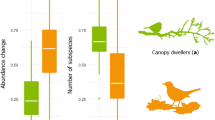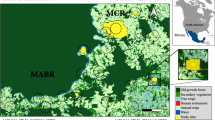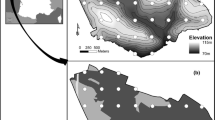Abstract
The usual positive inter-specific relationship between range size and abundance of local populations can have notable exceptions in Afrotropical montane areas, where range-restricted bird species are unusually abundant. We tested how the area occupied locally by passerines and their geographic range size relate to local abundances along a tropical elevational gradient of Mt Cameroon, West-Central Africa. Data on bird assemblages were collected at six forested elevations (350, 650, 1100, 1500, 1850 m, 2200 m a.s.l.) using a standardised point count at 16 locations per elevation. Elevational ranges of birds were compiled from published sources and their geographic range sizes were determined as the occupancy of 1° x 1° grid cells. The observed relationship between local abundance and geographic range size within the entire passerine assemblage on Mt Cameroon disagrees with the most frequently reported positive pattern. However, the patterns differ among elevations, with positive trends of the abundance-range size relationship in lowland changing to negative trends towards higher elevations. Interestingly, the total assemblage abundances do not differ much among elevations and population size estimates of species occupying different parts of the gradient remain relatively constant. These patterns are caused by relatively high abundances of montane species, which might be a result of long-term ecological specialization and/or competitive release in species-poor montane locations and possibly facilitated by an extinction filter. Our data suggest that montane species’ abilities to maintain dense populations might compensate for less area available near mountain tops and help these populations to circumvent extinction.






Similar content being viewed by others
References
Banks-Leite C et al (2014) Assessing the utility of statistical adjustments for imperfect detection in tropical conservation science. J Appl Ecol 51:849–859. doi:10.1111/1365-2664.12272
Bibby CJ, Burgess ND, Hill DA (2000) Bird census techniques. The essential overview of bird census techniques. Academic Press, London
Blackburn TM, Cassey P, Gaston KJ (2006) Variations on a theme: sources of heterogeneity in the form of the interspecific relationship between abundance and distribution. J Anim Ecol 75:1426–1439. doi:10.1111/j.1365-2656.2006.01167.x
Bock CE, Ricklefs RE (1983) Range size and local abundance of some North American songbirds—a positive correlation. Am Nat 122:295–299. doi:10.1086/284136
Borregaard MK, Rahbek C (2010) Causality of the relationship between geographic distribution and species abundance. Q Rev Biol 85:3–25. doi:10.1086/650265
Brown JH (1984) On the relationship between abundance and distribution of species. Am Nat 124:255–279. doi:10.1086/284267
Buckland ST et al (2001) Introduction to distance sampling. Oxford University Press, Oxford
Bussmann RW (2006) Vegetation zonation and nomenclature of African mountains—an overview. Lyonia 11:41–66
Cheek M, Cable S, Heppe FN, Ndam N, Watts J (1996) Mapping plant biodiversity on Mount Cameroon. In: Van der Maesen LJG, van der Burgt XM, van Medenbach de Rooy JM (eds) The biodiversity of African plants. Springer, the Netherlands, pp 110–120
Diamond JM (1970) Ecological consequences of island colonization by southwest Pacific birds 2. Effect of species diversity on total population density. Proc Natl Acad Sci 67:1715. doi:10.1073/pnas.67.4.1715
Djomo NE et al (2014) Comparison of avian assemblage structures in two upper montane forests of the Cameroon volcanic line: lessons for bird conservation. Biodivers Conserv 23:1469–1484. doi:10.1007/s10531-014-0677-7
Dowsett RJ (1986) Origins of the high-altitude avifaunas of tropical Africa. In: Vuilleumier F, Monasteuio M (eds) High altitude tropical biogeography. Oxford University Press, NewYork
Favalli M, Tarquini S, Papale P, Fornaciai A, Boschi E (2012) Lava flow hazard and risk at Mt. Cameroon volcano. Bull Volcanol 74:423–439. doi:10.1007/s00445-011-0540-6
Fjeldså J (1999) The impact of human forest disturbance on the endemic avifauna of the Udzungwa Mountains, Tanzania. Bird Conserv Int 9:47–62. doi:10.1017/S0959270900003348
Fjeldså J, Bowie RCK (2008) New perspectives on the origin and diversification of Africa’s forest avifauna. Afr J Ecol 46:235–247. doi:10.1111/j.1365-2028.2008.00992.x
Fjeldså J, Kiure J, Doggart N, Hansen LA, Perkin A (2010) Distribution of highland forest birds across a potential dispersal barrier in the Eastern Arc Mountains of Tanzania. Steenstrupia 32:1–43
Fjeldså J, Bowie RCK, Rahbek C (2012) The role of mountain ranges in the diversification of birds. Annu Rev Ecol Evol Syst 43(43):249–265. doi:10.1146/annurev-ecolsys-102710-145113
Fonge B, Yinda G, Focho D, Fongod A, Bussmann R (2005) Vegetation and soil status on an 80 year old lava flow of Mt. Cameroon, West Africa. Lyonia 8:17–39
Gaston KJ (1996) The multiple forms of the interspecific abundance-distribution relationship. Oikos 76:211–220. doi:10.2307/3546192
Gaston KJ, Blackburn TM (2000) Pattern and process in macroecology. Blackwell, Oxford
Gaston KJ, Blackburn TM, Greenwood JJD, Gregory RD, Quinn RM, Lawton JH (2000) Abundance-occupancy relationships. J Appl Ecol 37:39–59. doi:10.1046/j.1365-2664.2000.00485.x
Gill F, Donsker D (eds) (2014) IOC world bird list (version 4.2). http://www.worldbirdnames.org/. Accessed April 2014
Graham CH, Smith TB, Languy M (2005) Current and historical factors influencing patterns of species richness and turnover of birds in the Gulf of Guinea highlands. J Biogeogr 32:1371–1384. doi:10.1111/j.1365-2699.2005.01284.x
Hanski I, Kouki J, Halkka A (1993) Three explanations of the positive relationship between distribution and abundance of species. In: Ricklefs RE, Schlüter I (eds) Species diversity in ecological communities: historical and geographical perspectives. University of Chicago Press, Chicago, pp 108–116. http://earthexplorer.usgs.gov/. Accessed Nov 2013
Holt RD, Lawton JH, Gaston KJ, Blackburn TM (1997) On the relationship between range size and local abundance: back to basics. Oikos 78:183–190. doi:10.2307/3545815
Hořák D, Sedláček O, Reif J, Riegert J, Pešata M (2010) When savannah encroaches on the forest: thresholds in bird-habitat associations in the Bamenda Highlands, Cameroon. Afr J Ecol 48:822–827. doi:10.1111/j.1365-2028.2009.01155.x
Janzen DH (1973) Sweep samples of tropical foliage insects: effects of seasons, vegetation types, elevation, time of day, and insularity. Ecology 54:687–708. doi:10.2307/1935359
Janzen DH et al. (1976) Changes in the arthropod community along an elevational transect in the Venezuelan Andes. Biotropica 8:193–203. doi:10.2307/2989685
Price TD et al (2014) Niche filling slows the diversification of Himalayan songbirds. Nature 509:222. doi:10.1038/nature13272
Johnson CN (1998) Species extinction and the relationship between distribution and abundance. Nature 394:272–274. doi:10.1038/28385
Komonen A, Paivinen J, Kotiaho JS (2009) Missing the rarest: is the positive interspecific abundance-distribution relationship a truly general macroecological pattern? Biol Lett 5:492–494. doi:10.1098/rsbl.2009.0282
Lande R (1988) Genetics and demography in biological conservation. Science 241:1455–1460. doi:10.1126/science.3420403
Loiselle BA, Blake JG (1991) Temporal variation in birds and fruits along an elevational gradient in Costa Rica. Ecology 72:180–193. doi:10.2307/1938913
MacArthur H, Diamond JM, Karr JR (1972) Density compensation in island faunas. Ecology 53:330. doi:10.2307/1934090
McCain CM (2009) Global analysis of bird elevational diversity. Glob Ecol Biogeogr 18:346–360. doi:10.1111/j.1466-8238.2008.00443.x
O’Connor RJ (1987) Organization of avian assemblages: the influence of intraspecific habitat dynamics. In: Gee HR, Oilier PS (eds) Organization of communities: past and present. Blackwell, Oxford, pp 163–183
Proctor J, Edwards ID, Payton RW, Nagy L (2007) Zonation of forest vegetation and soils of mount cameroon, West Africa. Plant Ecol 192:251–269. doi:10.1007/s11258-007-9326-5
Purvis A, Gittleman JL, Cowlishaw G, Mace GM (2000) Predicting extinction risk in declining species. Proc R Soc B Biol Sci 267:1947–1952. doi:10.1098/rspb.2000.1234
Rahbek C et al (2012) One degree resolution database of the global distribution of birds. University of Copenhagen, Zoological Museum, Denmark
Reif J et al (2006) Unusual abundance-range size relationship in an Afromontane bird community: the effect of geographical isolation? J Biogeogr 33:1959–1968. doi:10.1111/j.1365-2699.2006.01547.x
Romdal TS (2001) Altitudinal distribution and abundance patterns of bird species in the Eastern Arc Mountains, Tanzania. Scopus 21:35–54
Ryan PG, Bento C, Cohen C, Graham J, Parker V, Spottiswoode C (1999) The avifauna and conservation status of the Namuli Massif, northern Mozambique. Bird Conserv Int 9:315–331. doi:10.1017/S0959270900003518
Sekercioğlu CH, Riley A (2005) A brief survey of the birds in Kumbira Forest, Gabela, Angola. Ostrich 76:111–117. doi:10.2989/00306520509485483
Shaffer ML (1981) Minimum population sizes for species conservation. Bioscience 31:131–134. doi:10.2307/1308256
Thomas L et al. (2010) Distance software: design and analysis of distance sampling surveys for estimating population size. J Appl Ecol 47:5–14. doi:10.1111/j.1365-2664.2009.01737.x
Voelker G, Outlaw RK, Bowie RCK (2010) Pliocene forest dynamics as a primary driver of African bird speciation. Glob Ecol Biogeogr 19:111–121. doi:10.1111/j.1466-8238.2009.00500.x
Williams SE, Williams YM, VanDerWal J, Isaac JL, Shoo LP, Johnson CN (2009) Ecological specialization and population size in a biodiversity hotspot: how rare species avoid extinction. Proc Natl Acad Sci 106:19737–19741. doi:10.1073/pnas.0901640106
Willig MR, Kaufman DM, Stevens RD (2003) Latitudinal gradients of biodiversity: pattern, process, scale, and synthesis. Annu Rev Ecol Evol Syst 34:273–309. doi:10.1146/annurev.ecolsys.34.012103.144032
Wright SJ (1980) Density compensation in island avifaunas. Oecologia 45:385–389. doi:10.1007/bf00540211
Acknowledgments
We wish to thank the communities of Bokwango and Bakingili villages for their support during the fieldwork. We are grateful to Francis Luma for fieldwork management. We thank the Department of Environmental Sciences of the University of Buea, Cameroon and in particular Eric Fokam, Philip Tem Dia, Philip Ngafor and Bertilla Sirri for their assistance during the fieldwork, and Jana Vokurková and Andrew Reeve for stimulating comments on earlier drafts of this manuscript. Tomáš Albrecht and David Storch helped us during point counts. We also thank Kevin Njabo and the IRTC of the University of California, Los Angeles in Yaoundé for their technical support. This study was performed with the authorisation no. 0104/PRBS/MINFOF/SG/DFAP/SDVEF/SC of the Ministry of Forestry and Wildlife of the Republic of Cameroon and with the support of Mt Cameroon National Park authorities. The research was funded by the Czech Science Foundation (project no. P505/11/1617), and J. F. acknowledges the Danish National Research Foundation for support to the Centre for Macroecology, Evolution and Climate.
Author contribution statement
D. H., M. F., J. F. and O. S. conceived the ideas; D. H., O. S., F. N. M., E. D. N., M. F. and K. M. collected the data; M. F. performed the statistical analysis; M. F., D. H. and J. F. wrote the manuscript; O. S. and E. D. N. contributed to the writing.
Author information
Authors and Affiliations
Corresponding author
Ethics declarations
Conflict of interest
The authors declare that they have no conflict of interest.
Additional information
Communicated by Ola Olsson.
Electronic supplementary material
Below is the link to the electronic supplementary material.
Rights and permissions
About this article
Cite this article
Ferenc, M., Fjeldså, J., Sedláček, O. et al. Abundance-area relationships in bird assemblages along an Afrotropical elevational gradient: space limitation in montane forest selects for higher population densities. Oecologia 181, 225–233 (2016). https://doi.org/10.1007/s00442-016-3554-0
Received:
Accepted:
Published:
Issue Date:
DOI: https://doi.org/10.1007/s00442-016-3554-0




